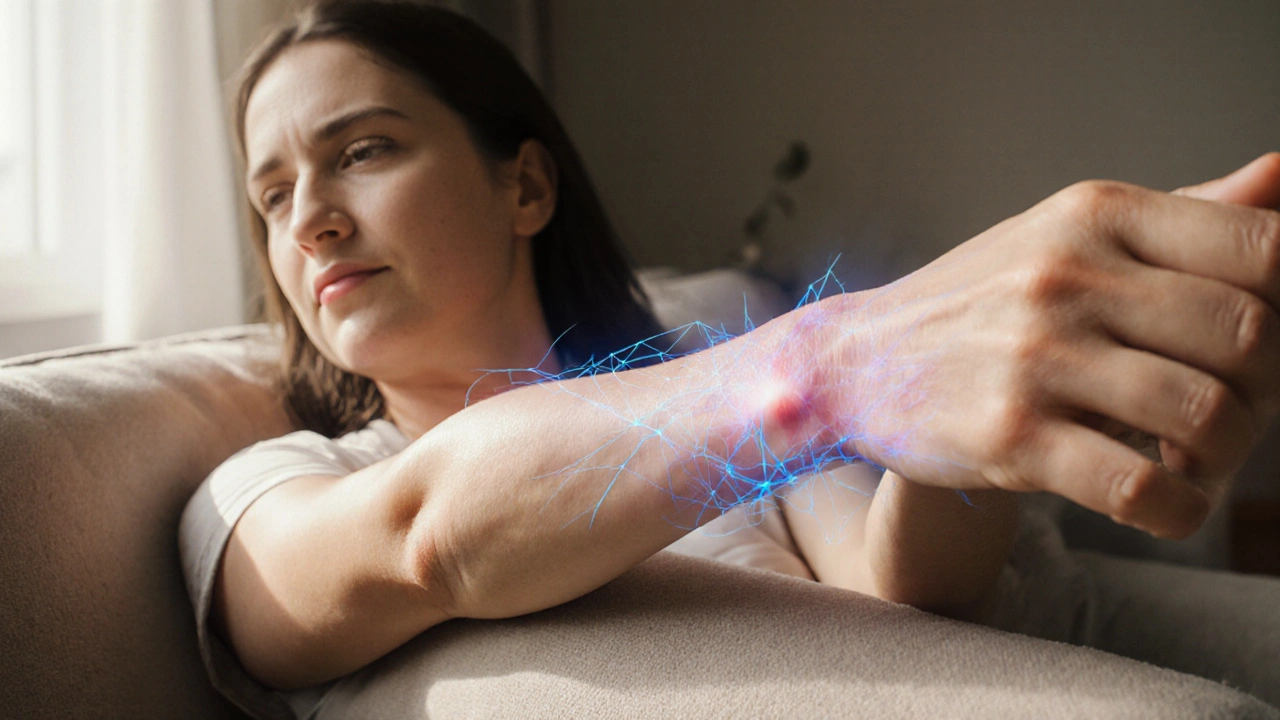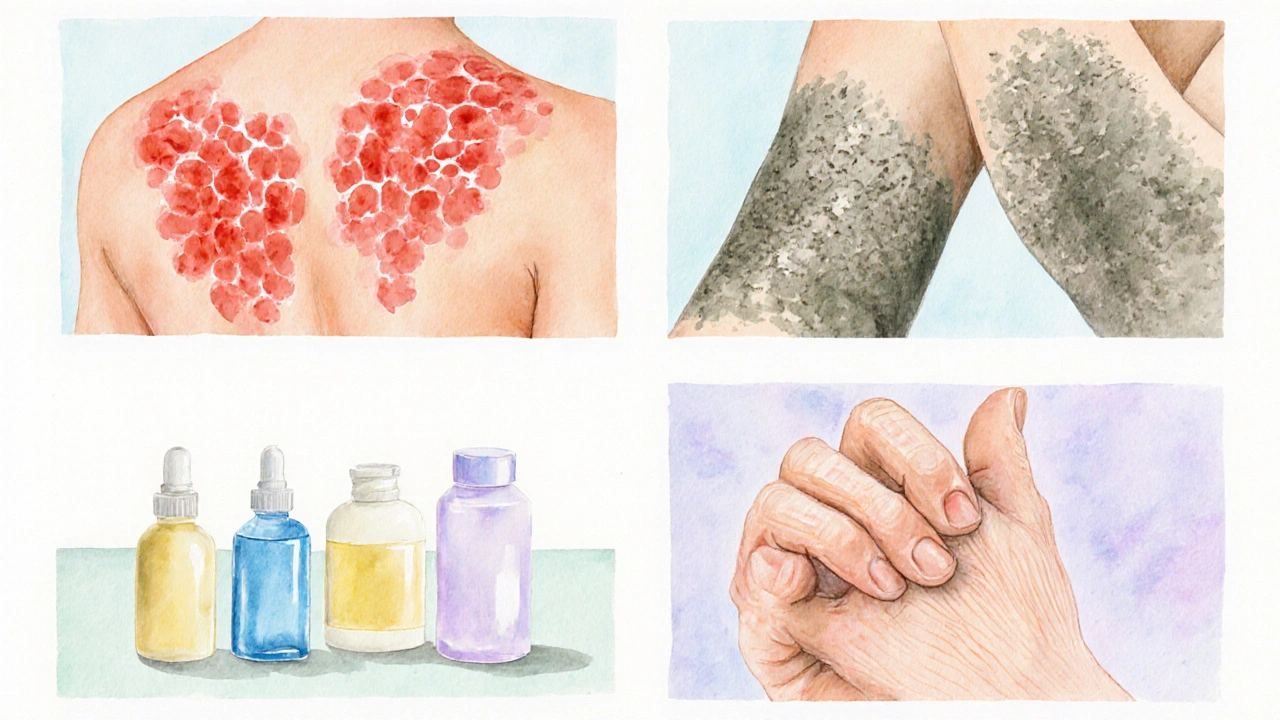Fibromyalgia Skin Symptoms: Rashes, Itching & Sensitivity Explained
 Oct, 10 2025
Oct, 10 2025
Fibromyalgia Skin Symptom Checker
Symptom Analysis
Possible Causes:
Suggested Management:
Living with fibromyalgia often feels like a battle against constant pain, but many people don’t realize that the skin can join the fight. Rashes, relentless itching, and an extra‑sensitive feeling under the surface are common complaints that can leave you frustrated and confused. This guide breaks down why these skin problems happen, what they look like, and how you can keep them under control.
Key Takeaways
- Fibromyalgia can trigger skin issues through central sensitization, small‑fiber neuropathy, and mast‑cell activation.
- Typical skin manifestations include urticaria, eczema‑like rashes, contact dermatitis, and intense pruritus.
- Topical moisturizers, antihistamines, and gentle stress‑reduction techniques are the first line of defense.
- Seek a doctor’s help if the rash spreads quickly, is painful, or is accompanied by fever or swelling.
- Long‑term management combines medication, skin‑care routines, and lifestyle tweaks to lower overall sensitivity.
What Is Fibromyalgia?
Fibromyalgia is a chronic pain syndrome characterized by widespread musculoskeletal aches, fatigue, and heightened pain sensitivity. Researchers believe the condition stems from a dysregulated nervous system that amplifies pain signals-a process called central sensitization. While the hallmark symptoms revolve around muscles and joints, the nervous‑system changes don’t stop there; they can affect the skin, too.

How Fibromyalgia Affects the Skin
Three biological pathways link fibromyalgia to skin problems:
- Central Sensitization: The brain and spinal cord become overly responsive, turning harmless skin sensations into painful or itchy triggers.
- Small‑fiber neuropathy reduces the density of tiny nerve fibers that normally regulate temperature and itch, leaving the skin hyper‑reactive.
- Mast‑cell activation releases histamine and other mediators, prompting rashes and pruritus even without an obvious allergen.
These mechanisms often overlap, meaning a single flare can feel like a burning sensation, a rash, and an itch all at once.
Common Skin Manifestations in Fibromyalgia
Not every rash means you have a separate skin disease. Below are the most frequently reported skin issues among fibromyalgia patients:
| Condition | Typical Appearance | Key Triggers | Usual Management |
|---|---|---|---|
| Urticaria (hives) | Raised, red welts that may swirl together | Stress, heat, sweating | Antihistamines, cool compresses, moisturizers |
| Eczema‑like rash | Dry, scaly patches, often on elbows or knees | Dry skin, friction, irritants | Barrier creams, gentle soaps, topical steroids (short term) |
| Contact dermatitis | Red, itchy rash where skin touched a substance | d>New detergents, fabrics, topical productsAvoidance, topical corticosteroids, barrier ointments | |
| Pruritus (chronic itching) | Persistent urge to scratch, may not have visible rash | Mast‑cell activation, neuropathic changes | Antihistamines, gabapentin, skin cooling gels |
| Burning or stinging sensations | Often described as “electric” or “pins‑and‑needles” | Small‑fiber neuropathy, temperature extremes | Capsaicin cream, low‑impact exercise, nerve‑modulating meds |
When to Seek Professional Help
Most skin flares can be handled at home, but you should call a healthcare provider if any of the following occur:
- The rash spreads rapidly or covers a large area in less than 24hours.
- You develop fever, swelling, or pain that feels deep rather than surface level.
- The itching becomes unmanageable, leading to skin breaks or infection.
- Over‑the‑counter treatments (antihistamines, moisturizers) provide no relief after a week.
- You notice new sensory changes, such as numbness or loss of temperature perception.
Doctors may order a skin biopsy to check for small‑fiber loss or run blood tests for mast‑cell markers, helping tailor treatment.

Managing Rashes and Itching
Effective skin care for fibromyalgia blends medical options with everyday habits:
Topical Strategies
- Moisturizers: Choose fragrance‑free creams with ceramides or hyaluronic acid. Apply within three minutes of a shower to lock in moisture.
- Antihistamine creams (e.g., diphenhydramine 1%): Good for localized hives, but avoid large‑area use because of possible skin irritation.
- Cooling gels containing menthol or aloe help calm burning sensations.
- Low‑dose topical steroids (hydrocortisone 1%) can be used for short bursts of eczema‑like flare‑ups.
Systemic Medications
- Oral antihistamines (cetirizine, fexofenadine) are first‑line for persistent itch.
- Neuropathic agents such as gabapentin or pregabalin not only reduce pain but also lessen pruritus linked to nerve irritation.
- In severe mast‑cell activation, doctors may prescribe cromolyn sodium or leukotriene modifiers.
Non‑Drug Approaches
- Stress reduction: Mindfulness meditation, breathing exercises, or gentle yoga can lower central sensitization by calming the nervous system.
- Temperature control: Keep indoor humidity around 45‑55% and avoid hot showers; cool baths are soothing for itchy skin.
- Gentle movement: Light walking or swimming improves circulation without over‑stimulating sensitive skin.
- Diet tweaks: Some patients notice less flare‑ups after reducing histamine‑rich foods (aged cheese, fermented drinks) and adding omega‑3 rich fish.
Long‑Term Lifestyle Strategies
Because fibromyalgia is a chronic condition, sustainable habits matter more than quick fixes.
- Consistent skin‑care routine: Shower with lukewarm water, use a mild, sulfate‑free cleanser, and moisturize twice daily.
- Sleep hygiene: Aim for 7‑9hours of uninterrupted sleep; poor sleep can amplify both pain and itch.
- Regular check‑ins with your clinician: Track flare patterns in a journal to help adjust medication doses.
- Support networks: Online fibromyalgia groups often share practical skin‑care tips and product recommendations that have worked for others.
When you combine these practices with appropriate medical treatment, many people see a noticeable drop in the frequency and intensity of skin symptoms.
Frequently Asked Questions
Why do I get itchy skin even when there’s no rash?
Itching without a visible rash often points to mast‑cell activation or small‑fiber neuropathy. Both are common in fibromyalgia and can be managed with antihistamines, neuropathic meds, and stress‑reduction techniques.
Are over‑the‑counter creams safe for long‑term use?
Fragrance‑free moisturizers and barrier ointments are safe indefinitely. However, regular use of topical steroids should be limited to a few weeks at a time to avoid skin thinning.
Can diet really influence skin flare‑ups?
For some people, high‑histamine foods or excessive sugar can worsen inflammation and itching. Keeping a food‑symptom diary helps identify personal triggers.
Should I see a dermatologist or a rheumatologist?
Start with your primary care doctor or rheumatologist; they can coordinate with a dermatologist if the skin issue needs specialized testing or treatment.
Is it normal for skin symptoms to flare during a pain flare?
Yes. The same central‑sensitization mechanisms that amplify pain also heighten skin sensitivity, so a pain flare often brings along itch or rash.

John Nix
October 10, 2025 AT 22:00Thank you for the comprehensive overview of fibromyalgia‑related skin manifestations. The distinction between central sensitization and small‑fiber neuropathy is articulated with clarity, and the suggested moisturization regimen appears both practical and evidence‑based.
Mike Rylance
October 11, 2025 AT 05:33Excellent summary! The emphasis on stress reduction and gentle movement aligns well with a holistic approach, and the step‑by‑step skin‑care routine is both realistic and encouraging for those managing daily flares.
Becky B
October 11, 2025 AT 19:26While the article presents useful tips, one must also consider that certain pharmaceutical companies have vested interests in promoting topical steroids, potentially downplaying alternative natural remedies that could alleviate symptoms without hidden agendas.
Aman Vaid
October 12, 2025 AT 23:13Central sensitization represents a maladaptive amplification of nociceptive pathways within the central nervous system. This phenomenon is not limited to musculoskeletal pain but extends to cutaneous sensory processing. Consequently, innocuous tactile stimuli may be interpreted as pruritic or painful sensations. Small‑fiber neuropathy, characterized by a loss of epidermal nerve fibers, further compromises the ability to discriminate temperature and itch. Histological studies have quantified a reduction of up to 30 % in intra‑epidermal nerve fiber density among fibromyalgia cohorts. Mast‑cell activation contributes additional mediators such as histamine, tryptase, and prostaglandins, which perpetuate inflammation and vasodilation. The interplay between these mechanisms creates a feedback loop wherein stress exacerbates mast‑cell degranulation, which in turn heightens central sensitization. Clinically, patients frequently report a constellation of symptoms including urticaria, eczema‑like eruptions, and chronic pruritus without overt dermatoses. Management therefore necessitates a multimodal strategy that addresses both peripheral and central contributors. Topical barrier repair with ceramide‑rich moisturizers restores lipid homeostasis and reduces transepidermal water loss. Systemic antihistamines, particularly second‑generation agents, attenuate histamine‑mediated itch while minimizing sedation. Neuromodulators such as gabapentin or pregabalin have demonstrated efficacy in reducing neuropathic itch by modulating calcium channel activity. Adjunctive non‑pharmacologic interventions, including mindfulness‑based stress reduction, have been shown to down‑regulate cortical excitability associated with central sensitization. Patients should also be counseled on environmental controls, such as maintaining ambient humidity between 45 and 55 % and avoiding extreme temperature fluctuations. Dietary modifications, notably the reduction of high‑histamine foods, may further diminish mast‑cell activation in susceptible individuals. Regular follow‑up with a multidisciplinary team enables dynamic adjustment of therapeutic regimens and promotes sustained symptom control.
xie teresa
October 14, 2025 AT 03:00I really appreciate how clearly you broke down those mechanisms; it helps me understand why my skin feels so reactive during stress peaks, and I’ll definitely try incorporating more moisturizers and mindfulness into my daily routine.
Srinivasa Kadiyala
October 15, 2025 AT 06:46Interesting article, however, one must question the over‑reliance on antihistamines, because, in many cases, these drugs merely mask symptoms, do not address the underlying small‑fiber neuropathy, and prolonged use can lead to tachyphylaxis, especially when patients are simultaneously exposed to environmental allergens, dietary triggers, and psychosocial stressors, which together compose a far more complex picture than the piece suggests.
Alex LaMere
October 16, 2025 AT 10:33Short: Antihistamines alone won’t fix the nerve loss. 😑
Dominic Ferraro
October 17, 2025 AT 14:20Great job! Your guide gives hope, and with a steady skin‑care routine plus gentle exercise you can tame those annoying flares and reclaim comfort.
Jessica Homet
October 18, 2025 AT 18:06Honestly, I’ve tried the “gentle exercise” tip and it barely made a dent; the itching still drives me nuts.
Bailey Granstrom
October 19, 2025 AT 21:53Flare after flare? Push through, the battle ends with perseverance.